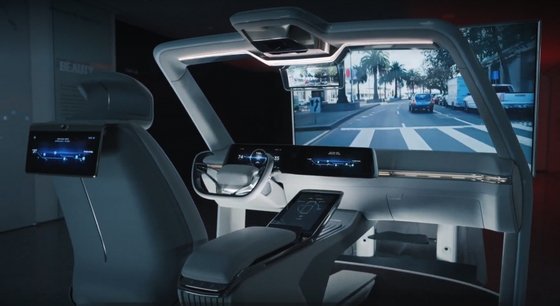
A next-generation vehicle display by LG Electronics.
According to the electronics industry on June 16, LG Electronics has developed an algorithm that overcomes the limitations of viewing angles on vehicle OLED displays and has filed for a patent. This technology allows drivers to view car infotainment systems, such as navigation, on OLED displays without any color or brightness distortion, just as if they were looking directly at it.
This was a major focus of last year's research by the Display Advanced Technology Task team within LG Electronics' VS Research Institute. LG Electronics is the only global supplier pushing commercialization of this technology that resolves the viewing angle distortion of OLED displays. Last month, LG Electronics presented this technology at the world's most prestigious display conference, SID2024, in San Francisco, U.S.
As the mobility industry shifts towards Software-Defined Vehicles (SDV), the role of in-vehicle displays is becoming increasingly significant. Activities such as watching movies or playing games inside vehicles are diversifying, leading to larger display sizes and higher image quality. OLED displays are becoming more popular in vehicles instead of liquid crystal displays (LCDs) due to these trends. According to market research firm Omdia, by 2030, one in two premium vehicle displays will utilize OLED.
Although OLED offers superior image quality compared to LCD, which can maintain quality viewing from the sides without distortion, OLED suffers from greater distortion when viewed from an angle. As vehicle OLED displays become more widespread and the digital cockpit covers more of the front area of both the driver and passenger seats with displays, the issue of distortion is expected to grow. LG Electronics stated that their newly developed algorithm can improve this problem, reducing color and brightness distortions when viewed from the side by 20-30%.
The algorithm is versatile, applicable to all forms of displays used in vehicles, and can also be supplied in a finished product form. However, LG Electronics also offers to apply only their software to displays from other manufacturers already installed in vehicles if requested by car manufacturers. This diversification of order methods is part of a strategy to enhance the portfolio of the VS business. LG Electronics plans to mass-produce this algorithm technology and continue supplying next-generation products.
As the vehicle display market grows, the shapes of displays and solutions for SDVs are becoming increasingly diverse. On June 13, Samsung Display announced that it had exclusively equipped BMW Group's premium compact car brand 'MINI' with a newly developed circular OLED display, the first of its kind in the industry, made for Central Information Displays (CID). Hyundai Mobis also recently unveiled “M.VICS 5.0,” a next-generation integrated cockpit system with moving display panels suited for vehicle environments.
LG Electronics organized a display advanced technology task force in 2022 to research and develop display components for future vehicles, including virtual displays. According to Omdia, the global vehicle display market, which was valued at 11.4 trillion won in 2022, is expected to grow at an annual rate of 7.8%, reaching 16.3 trillion won by 2027.
TrendForce 2023 Global Automotive LED Product Trend and Regional Market Analysis
Release Date:
1. PDF (166 Pages)- 30 June 2023
2. EXCEL- 30 June 2023 and 31 December 2023
Languages: Traditional Chinese / English
If you would like to know more details , please contact:





 CN
TW
EN
CN
TW
EN






